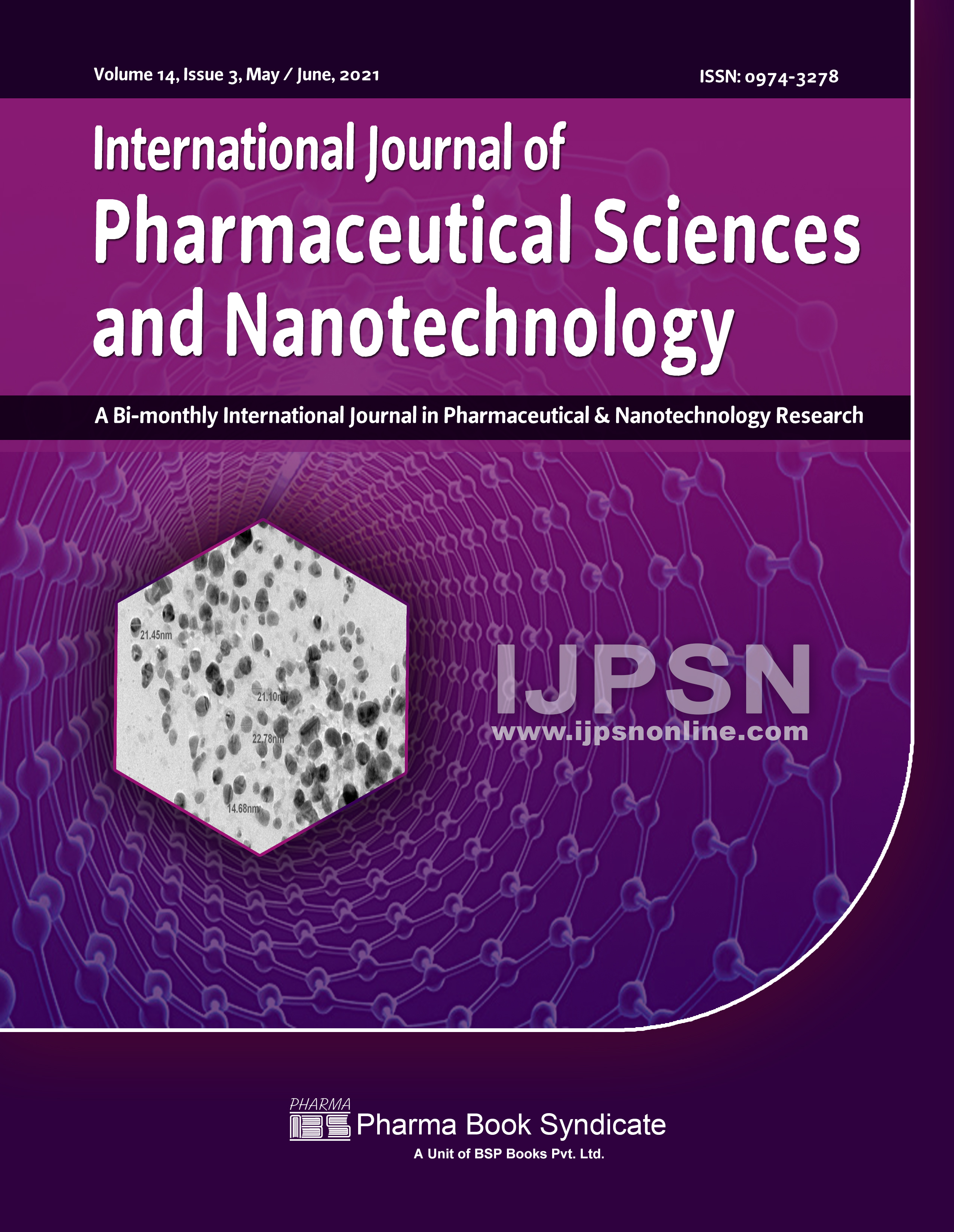Colorimetric Studies on the Interaction of Quinhydrone with Monosodium Glutamate (MSG) in Aqueous Medium
DOI:
https://doi.org/10.37285/ijpsn.2021.14.3.2Abstract
The interaction of quinhydrone with monosodium glutamate (MSG) in aqueous medium has been investigated using colorimetric method at different pH conditions. Quinhydrone is a mixture of quinone and hydroquinone. In acidic pH, hydroquinone is dominating and the hydroxyl group of hydroquinone interacts with the amino/carboxylic acid group of glutamate ion due to hydrogen bonds thus influences the solution. While in alkaline pH, the colour of the quinhydrone is brown due to benzoquinone being dominating component and can interact with amino group of glutamate ion thus resulting in the formation of di-anilido-quinone. This will lead to an increase of intensity of quinhydrone solution. Glutamate being amphoteric in nature, provides an option to examine it in both acidic and alkaline pH. The effectiveness of detection of MSG in alkaline medium is better due to its favourable interactions.
Downloads
Metrics
Keywords:
monosodium glutamate, quinhydrone, colorimetry, detectionDownloads
Published
How to Cite
Issue
Section
References
Israelachvili J (2010). Intermolecular and Surface Forces, Third Edition; Academic Press, London.
Regeimbal J, Gleiter S, Trumpower BL, Yu C-A, Diwakar M, Ballou DP, and Bardwell JCA (2003). Disulfide bond formation involves a quinhydrone-type charge-transfer complex, Proc National Acad Sci 100: 13779-13784.
Cramer WA, and Knaff DB (1990). Energy Transduction in Biological Membranes, ed. C. R. Cantor, chapter 4, Springer, New York, USA.
Matsuda H, Osaki K, and Nitta I (1958). Crystal Structure of Quinhydrone, C12H10O4, Bull Chem Soc Japan, 31: 611-620.
Swallow AJ (1982). Physical chemistry of quinones: functions of quinones in energy conserving systems, ed. B. L. Trumpower, Chapter 2, Academic Press, New York, USA.
Abu-Taweel GM, Ajarem JS, and Ahmad M (2014). Cognitive and biochemical effects of monosodium glutamate and aspartame, administered individually and in combination in male albino mice. Neurotoxicology and Teratology, 42: 60-67.
Dobson CM, and Winter NS (2014). The Identification of Amino Acids by Interpretation of Titration Curves: An Undergraduate Experiment for Biochemistry, World J Chem Edu2:59-61.
Ramesh TN, Udagani C, Sharathchandra RG, and Yathish MC (2018). Spectrophotometric method for the determination of monosodium glutamate using ferric salt solution as chromogenic agent, in Pro Nat ConfCurrent Adv Chem Sci, Tumkur, 82-85.
Durán-Merás I, Salinas F, Muñoz De La Peña, and López Rosas M (1993). Simultaneous determination of flavor enhancers inosine 5'-monophosphate and guanosine 5'-monophosphate in food preparations by derivative spectrophotometry, J AOAC Inter 76:754-759.
Conacher HB, Iyengar JR, Miles WF and Botting HG (1979).Gas-liquid chromatographic determination of monosodium glutamate in soups and soup bases. J Assoc Anal Chem 62: 604.
Thayyath AS, and Alexander S (2015). Selective determination of monosodium glutamate (Ajinomoto) in food samples using a potentiometric method with a modified multiwalled carbon nanotube based molecularly imprinted polymer, RSC Adv 5: 96840.
Krishna VN, Karthika D, Surya DM, Rubini MF,Vishalini M and Pradeepa YJ (2010). Analysis of Monosodium l-Glutamate in Food Products by High-Performance Thin Layer Chromato-graphy, J Young Pharm2:297.
Devi R, Gogoi S, Barua S, Dutta HS, Bordoloi M, and Khan R (2019). Electrochemical detection of monosodium glutamate in foodstuffs based on Au@MoS2/chitosan modified glassy carbon electrode, Food Chem 276: 350-357.
Mulyasuryani A, and Prasetya DED (2019). Development of chemical sensor for detection of monosodium glutamate by polyvinyl alcohol-Fe3O4 membrane on screen printed carbon electrode, IOP Conference Series: Mater Sci Eng 546: 032022.
Alnokkari A, Ataie M, and Alasaf Z (2013). Colorimetric Determination of Monosodium Glutamate in Food Samples Using Colorimetric Determination of Monosodium Glutamate in Food Samples Using L-glutamate Oxidase-glutamate Oxidase, Chinese Journal of Applied Environmental Chemistry, 19:1069-1072.
Kudekar DY, Kudale AS, Oberoi RK, Kulkarni RR, and Chutke NL (2016). Unusual detection of monosodium glutamate as an adulterant in mephedrone sample: confirmation by raman spectroscopy and composition by simple solubility differences, Chem Sci Trans 5: 488-492.
Yoshimura H (1936). Cause of the potential drift of quinhydrone electrode applied to solutions of alkaline buffer, of amino acid or of protein, or to plasma. J Biochem 23: 187-210.
Fieser LP (1928). The tautomerism of hydroxy quinones, J Amer Chem Soc 50: 439-465.
Ahmed M and Khan ZH (2000). Electronic absorption spectra of benzoquinone and its hydroxy substituents and effect of solvents on their spectra. Spectrochimica Acta A:Molecular Biomolecular Spec 56(5): 965-81.
Sheshan PK (1936). The absorption spectra of some aromatic compounds, Part II, quinones and hydroquinones, Pro Indian AcadSci, Section-A, 3:172-187.






